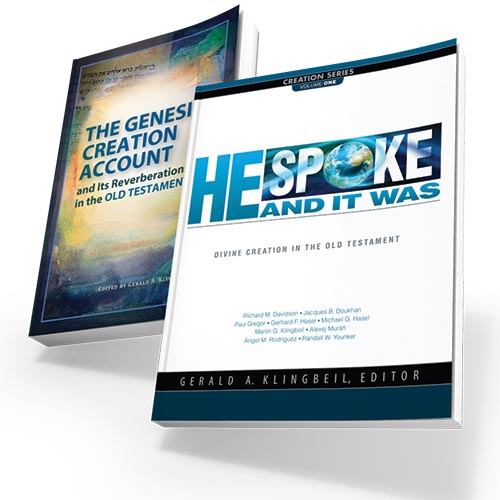
 The Genesis Creation Account and Its Reverberations in the Old Testament
The Genesis Creation Account and Its Reverberations in the Old TestamentEd. Gerald A. Klingbeil, Berrien Springs, Michigan: Andrews University Press, 2015, 395 pages, US$24.99.
Ed. Gerald A. Klingbeil, Nampa, Idaho: Pacific Press Pub. Assn., 2015, 186 pages, US$17.99.
For the past few decades, the creation account in Genesis 1 and 2 has been the subject of intense discussion within the Seventh-day Adventist Church. A number of theologians and scientists within the church have argued that the seven-day creation account should not be taken literally. They believe that God created life on this planet over millions of years, accommodating the basic outline of evolutionary theory.
These two books address one important aspect of this issue: how did authors of the other Old Testament books relate to the creation accounts in Genesis 1 and 2?
In the first volume, produced by the Biblical Research Institute in collaboration with the Geoscience Research Institute and the Faith and Science Council, 10 Adventist scholars investigate references to creation in the Old Testament. The book aims to help scientists and interested nonspecialists grasp the significance of biblical creation terminology and theology. A future volume will focus on the relevant data in the New Testament.
The Genesis Creation Account is divided into three main sections. In the first section, “Biblical Cosmology,” the authors show that biblical cosmology cannot be read through the glasses of pagan cosmologies of the ancient Near East and Egypt. The biblical worldview knows of no three-storied or triple-decked universe. That ancient Hebrews believed the heavens consisted of a solid vault resting on a flat earth is not found in Scripture and appears to have emerged for the first time in the early nineteenth century.
The second section, “Creation Accounts and Creation Theology,” is introduced by a comprehensive discussion of the when, who, how, and what of creation in Genesis 1 and 2. The rest of the chapters trace creation imagery and theology in the Pentateuch, wisdom literature, and prophetic books. The creation terminology in the wisdom books (Job, Psalms, Proverbs, and Ecclesiastes) is deeply rooted in Genesis 1 and 2. Death and pain are recognized as foreign to the original creation, the results of human sin. In the prophetic literature of the Old Testament, creation is the point of departure for the prophetic worldview. Prominent in the prophetic books is the triad: creation, de-creation, and re-creation.
The third section on creation, evolution, and death has two interesting chapters. The first one, “Biblical Creationism and Ancient Near Eastern Evolutionary Ideas,” investigates speculation about the origin of life and its development from such simple elements as water, matter, and time in ancient myths. These self-created elements are personified in the myths as divine beings who undergo an evolutionary process. The author’s conclusion is that this is not the same as natural evolution as understood today. Nevertheless, these myths contain elements of the evolutionary ideology promoted in scientific circles today.
The second article, “ ‘When Death Was Not Yet’: the Testimony of Biblical Creation,” explores the question of the origin of death. While evolution teaches that death is a natural and necessary process in the struggle for life, Scripture explains that death was not part of the original creation; it is the consequence of human sin. Biblical writers looked forward to the new creation of heaven and earth, where death shall be no more.
The second volume,
He Spoke and It Was, is a simplified edition of the scholarly first volume. While the text is only slightly simplified, the footnotes of the scholarly volume are drastically reduced. For example, the first chapter in the scholarly volume has 108 footnotes; in the simplified version it has only 36. Similarly, the last chapter has 41 footnotes in the scholarly volume, but only five in the simplified edition.
These volumes do not claim to answer all the questions concerning the biblical creation record, but the textual evidence presented clearly argues for an overarching understanding and theology of creation in the Old Testament. In the context of the current creation debate in the Seventh-day Adventist Church, these volumes are a helpful resource for members themselves to make informed decisions concerning the issue of creation/evolution. They clearly portray an overarching understanding of creation in the books of the Old Testament.
Gerhard Pfandl is a part-time associate director of the Biblical Research Institute.